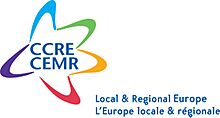Council of European Municipalities and Regions facts for kids
The Council of European Municipalities and Regions (CEMR) is the biggest group of local and regional governments in Europe. Think of it as a club for towns, cities, and regions from all over the continent.
Its members are 60 national groups from 41 different countries. These groups represent about 130,000 local governments, from small villages to big cities. The CEMR helps them work together and have their voices heard.
The president of CEMR is Gunn Marit Helgesen, a politician from Vestfold and Telemark in Norway. The main office is in Brussels, Belgium, where a team of about 30 people works to support the members.
Most of the CEMR's money comes from its member groups. A smaller part, about 15%, is given by the European Commission. The CEMR is also the European branch of a worldwide organization called United Cities and Local Governments.
Contents
How the CEMR Started
The CEMR was created in Geneva, Switzerland, on January 28, 1951. It was started by a group of European mayors who wanted to build a peaceful and united Europe after World War II.
At first, it was called the Council of European Municipalities (CEM). Later, larger areas called regions were also invited to join. That's when it changed its name to the Council of European Municipalities and Regions.
Who Leads the CEMR?
The president is the main leader of the CEMR. Since December 2022, the president has been Gunn Marit Helgesen from Norway.
Here are some of the past presidents:
- Stefano Bonaccini, president of the Emilia-Romagna region in Italy (2016–2022)
- Íñigo de la Serna, former mayor of Santander in Spain (2015–2016)
- Annemarie Jorritsma, former mayor of Almere in the Netherlands (2013–2015)
- Wolfgang Schuster, former mayor of Stuttgart in Germany (2010–2013)
- Michael Häupl, former mayor of Vienna in Austria (2004–2010)
- Valéry Giscard d'Estaing, former president of France (1997–2004)
What Does the CEMR Do?
The main goal of the CEMR is to help build a strong and united Europe where local communities have a say in how things are run. It helps local and regional leaders share ideas and learn from each other.
The CEMR also works to influence laws made by the EU. Many EU laws affect daily life in towns and cities, so the CEMR makes sure that the opinions of local leaders are heard before these laws are passed.
Main Areas of Work
The CEMR focuses on five key areas that are important for people and their local governments:
- Government and Being a Citizen: Making sure local governments are run fairly and that people can participate in decisions.
- Environment and Energy: Working on issues like climate change and finding clean energy sources.
- Working with the World: Helping European towns and regions connect with partners around the globe.
- Local Services: Improving public services like buses, parks, and libraries.
- Community Strength: Making sure all areas, rich or poor, have what they need to succeed.
Important Documents
The CEMR has created some very important documents. In 1953, it created the Charter of Local Liberties. This document was a big inspiration for the Charter on Local Self-Government, which was adopted by the Council of Europe in 1985 and protects the rights of local governments.
In 2006, the CEMR also launched the European Charter for Equality of Women and Men in Local Life. Over 1,800 local and regional governments have signed it, promising to treat men and women equally in their communities.
Working for Gender Equality
The CEMR believes that everyone should be treated fairly, no matter their gender. That's why it created the European charter for equality of women and men in local life in 2006.
When a town or region signs this charter, they promise to work towards making life fairer for both women and men. This could mean making sure women have the same job opportunities as men or ensuring public spaces are safe for everyone.
To check how well the charter is working, the CEMR started an "Observatory" in 2012. This group watches and reports on the progress made by the towns and regions that signed the charter.
Connecting Towns Through Twinning
Town twinning is when a town in one country becomes partners with a town in another country. The CEMR sees this as a great way to help people from different parts of Europe get to know each other.
There are now more than 30,000 twinning partnerships across Europe. These partnerships lead to school exchanges, cultural festivals, and friendships that cross borders.
The CEMR organizes events to support town twinning. For example, in 2007, it held a conference in Rhodes, Greece, called Twinning for tomorrow's world. Leaders from all over Europe came to share ideas on how to make twinning even better.
See also
- Congress of the Council of Europe
- European Union Regional policy
- List of micro-regional organizations



